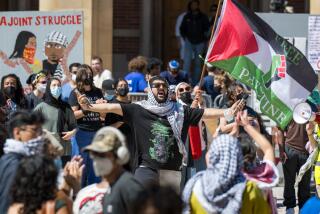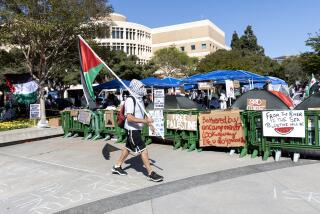Radical Redux : CSUN Activism Still Alive on 20th Anniversary of Campus Hostage Incident
- Share via
After 20 years, memories fade, and former Cal State Northridge football coach Sam Winningham, now retired, says he has tried to forget most of what happened on Nov. 4, 1968.
That was the day he came home a little later than usual and, after seeing him, his wife asked in all innocence, “What happened to you?”
Winningham said he still isn’t sure. That day, he and 33 school administrators and employees were taken hostage in a 4-hour takeover of the college administration building by black students who were demanding more opportunities for minorities at the nearly all-white college.
The incident kicked off a year of campus demonstrations that resulted in hundreds of arrests and a 10-page Life magazine story. The formerly quiet suburban school, then known as San Fernando Valley State College, earned a reputation as one of the more militant in the country.
But after years of relative quiet at the 30,000-student school, a new crop of campus activists said their interest in social and political issues is as strong as ever. Membership in such organizations as Amnesty International has doubled this year over last year, students said.
“We’re just exploding in terms of social awareness, and a lot of the issues are the same as 20 years ago,” said Lisa Sherwood, 22, a former sorority member and one of the campus’ most visible activists.
That may be, but clearly tactics have changed. Now the student activists choose cooperation over confrontation.
Today’s demonstrators get the necessary permits before they hang their protest banners in the school’s Student Union.
And they bother to ask classroom teachers to announce a demonstration, and are disappointed when few professors are willing.
Twenty years ago, “we would have gone into classes, told the professor to sit down and said, ‘This is the way it is,’ ” said Mike Lee, a 1960s CSUN activist, now a deputy public defender in the Van Nuys Courthouse. “We were a group of arrogant sons-of-bitches; we thought we were right, and we were.”
That conviction on such issues as racial equality and the Vietnam War enabled a relatively small group of activists to persuade hundreds of fellow students to risk arrest and police beatings by joining in marches, Lee said. Now, the activists attract 100 or fewer listeners to most campus demonstrations.
Former students, some now professors at the school, say the violent protests eventually forced school administrators to establish minority recruiting programs, as well as the college’s Pan-African and Chicano studies programs, which remain today.
Lee and others have been trying to track down CSUN alumni who participated in student unrest at the campus during the late 1960s. He hopes that many of them will show at a campus demonstration Wednesday to mark the 20th anniversary of the CSUN uprisings.
The effort is not just nostalgic, Lee said. The issues of racism and fairness in U.S. foreign policy are not over, he said. “Today’s students are raising those same issues.”
On a recent Saturday night, about 20 students who are CSUN’s most dedicated activists gathered in a first-floor apartment across from the campus. The organizations represented by the students included the Committee in Solidarity with the People of El Salvador, Amnesty International, Students Against Apartheid and Progressive Young Democrats.
For the most part, the students said, their goal is to stop U.S. aid to the government of El Salvador, cease all U.S. covert operations in foreign countries, end South Africa’s system of apartheid and increase domestic spending on a variety of social ills such as poverty and homelessness.
The meeting was partly business, partly social--a strategy session over beer and chips. After plans for an upcoming rally were finished, the group watched videotaped TV news reports from a protest in Westwood the previous weekend. They cheered members of the group when they appeared in the broadcasts.
Charlie Wilken, 33, a senior member of the loose-knit group, said it’s tough to keep people interested in topics as dreary as oppression in Central America. So he tries to make the gatherings more like small parties.
“We do social things together to build friendships that keep people involved beyond the political issues,” said Wilken, who is completing requirements for a teacher’s credential so he can teach science to Los Angeles schoolchildren. He is an outgoing leader, and on this night, he encourages one of the women at the meeting to be speaker for the first time at an upcoming rally.
“That’s how you learn,” Wilken said. The woman reluctantly agreed to speak.
Even socially, the times have changed. “Nobody does drugs because that would support the Contras, and there’s no free love because of AIDS,” said Jeff Hinte, 21. “We’re pretty puritanical, we don’t even get drunk.”
‘A Lot of Latitude’
On campus, the 30 or 40 regular activists at CSUN keep a couple of tables with literature near the entrance to Sierra Hall, even though the administration has banned tables there. The administration has chosen to ignore the ban as part of the give-and-take that students and officials said keep things peaceful.
“We give them a lot of latitude,” said Lt. Mark Hissong, campus police spokesman. He knows most of the student leaders by name and attends their campus demonstrations to make sure they don’t disrupt classes or other university business.
Hissong, a retired Los Angeles Police Department administrator, said no student has been arrested for demonstrating in the 8 years he’s worked there.
“They’re usually as peaceful as this,” Hissong said at last week’s demonstration against CIA activities.
“The cops are OK,” Hinte said. “They’re smart enough to know that part of what started the ‘60s thing was police repression.”
Bill Burwell, one of the founders of the school’s Black Student Union and a former professor in the school’s Pan-African studies department, was one of hundreds of students arrested and beaten by police in campus demonstrations. One result of the unrest, he said is that there are 20 times the number of black and Latino students at the school than there were in 1968.
Firing Demanded
“In 1968, it was unheard of to find a black person in Northridge,” Burwell said. “And that was the time when we started making demands.”
The first demand by the school’s Black Student Union was the firing of a white coach who apparently had shoved a black player during a freshman game in October that year, recalled the coach’s supervisor, former head coach Winningham. He said he agreed to meet with some Black Student Union members to talk it over, but already had decided he would stand behind his coach.
“I was more worried about winning football games, but we had a growing Black Student Union that was concerned with other issues,” Winningham said.
No agreement could be reached with the black students, voices were raised and Winningham and three others were marched to the administration building and put in a room.
Deal Rescinded
Soon, more than 400 students gathered around the administration building, while another 200 were inside, newspaper accounts said. Several hours later, the university agreed to the Black Student Union’s demands in exchange for the hostages but the deal was later rescinded.
“I just can’t believe that was the way to accomplish it, but I’m a realist to know that sometimes things like that are necessary,” Winningham said.
Hinte said CSUN activists are not interested in demonstrations that would draw police, although he and other students have been arrested for peaceful civil disobedience off the Northridge campus. But that could change, he said.
“There are probably less than 100 people here who are active politically,” said Hinte, who last year was named the school’s outstanding scholar. “But if there were a direct military intervention in, say, Central America, we would want to shut down this campus.”
More to Read
Sign up for Essential California
The most important California stories and recommendations in your inbox every morning.
You may occasionally receive promotional content from the Los Angeles Times.










